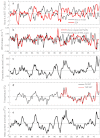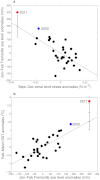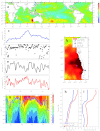La Niña forces unprecedented Leeuwin Current warming in 2011
- PMID: 23429502
- PMCID: PMC3572450
- DOI: 10.1038/srep01277
La Niña forces unprecedented Leeuwin Current warming in 2011
Abstract
Unprecedented warm sea surface temperature (SST) anomalies were observed off the west coast of Australia in February-March 2011. Peak SST during a 2-week period were 5°C warmer than normal, causing widespread coral bleaching and fish kills. Understanding the climatic drivers of this extreme event, which we dub "Ningaloo Niño", is crucial for predicting similar events under the influence of global warming. Here we use observational data and numerical models to demonstrate that the extreme warming was mostly driven by an unseasonable surge of the poleward-flowing Leeuwin Current in austral summer, which transported anomalously warm water southward along the coast. The unusual intensification of the Leeuwin Current was forced remotely by oceanic and atmospheric teleconnections associated with the extraordinary 2010-2011 La Niña. The amplitude of the warming was boosted by both multi-decadal trends in the Pacific toward more La Niña-like conditions and intraseasonal variations in the Indian Ocean.
Figures







References
-
- Walther G. R. et al. Ecological responses to recent climate change. Nature 416, 389–395 (2002). - PubMed
-
- Sexton J. P., McIntyre P. J., Angert A. L. & Rice K. J. Evolution and ecology of species range limits. Annu. Rev. Ecol. Evol. Syst. 40, 415–436 (2009).
-
- Conover D. O. & Present T. M. C. Countergradient variation in growth rate: compensation for length of the growing season among Atlantic silversides from different latitudes. Oecologia 83, 316–324 (1990). - PubMed
-
- Byrne M. Impact of ocean warming and ocean acidification on marine invertebrate life history stages: vulnerabilities and potential for persistence in a changing ocean. Oceanogr. Mar. Biol. Ann. Rev. 49, 1–43 (2011).
-
- Peck L. S., Webb K. E. & Bailey D. M. Extreme sensitivity of biological function to temperature in Antarctic marine species. Functional Ecology 18, 625–630 (2004).
Publication types
LinkOut - more resources
Full Text Sources
Other Literature Sources

